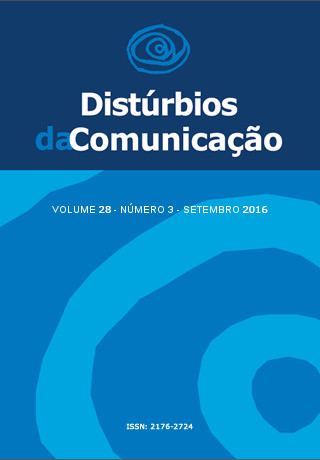Audiometría de refuerzo visual en infantes nacidos a término y pre – término: nivel mínimo de respuesta
Palabras clave:
Audiometría, Audicíon, Comportamiento del Lactante, Lactante.Resumen
Evaluar los Nivel Mínimo de Respuesta(NMRs) en infantes, nacidos a término y pre-término, teniendo en cuenta algunas variables. Además de investigar la relación entre el NMR y diferentes indicadores de riesgo para la pérdida auditiva(IRPAs). Metodos: La muestra fue constituida por 114 infantes que aprobaran el la Screeening Auditivo para Recién (SARN), com seis a ocho meses, divididos en dos grupos según la edad gestacional. Grupo Término: 75 infantes y Grupo pre-término: 39 infantes. La Audiometría de Refuerzo Visual (ARV) se realizó con el audiómetro pediátrico, buscando el NMR. Resultados: No hubo diferencia estadísticamente significativa entre NMR en relación al lado de la presentación. El NMR en 2 KHz y 4 KHz en el Grupo Término fueron inferiores en bebés de sexo femenino. Al comparar el NMR entre los dos grupos no hubo diferencia estadísticamente significativa. Los infantes que presentaron los IRPA: estancia en la unidad de terapia intensiva (UTI), el uso de medicamentos ototóxicos, la ventilación mecánica y el uso de tabaco por la madre durante el embarazo presentaron mayor NMRs. Conclusión: No hubo diferencia estadísticamente significativa en los NMRs en relación al lado de la presentación de los estímulos y entre los grupos. Se observó que los infantes del sexo femenino del Grupo Término tenían NMRs más bajos en la frecuencia de 2 KHz y 4 KHz. Algunos IRPAs influyen en el rendimiento de los infantes en la ARV.
Descargas
Métricas
Descargas
Publicado
Número
Sección
Licencia
Derechos de autor 2016 Laís Ferreira, Amália El Hatal de Souza, Bianca Bertuol, Ândrea de Melo, Inaê Costa Rechia, Eliara Pinto Vieira Biaggio

Esta obra está bajo una licencia internacional Creative Commons Atribución 4.0.









